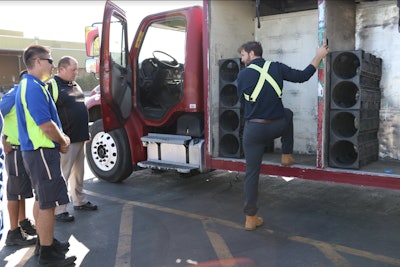
Yet workplace injuries in the United States cost businesses nearly $60 billion in direct workers compensation costs in 2018, according to Liberty Mutual’s workplace safety index. Injuries also cost businesses 104 million lost production days.
Shoulder, back and other musculoskeletal incidents occur regularly when loading and unloading freight and working around heavy equipment. Fleets are already struggling to find and retain qualified drivers. Losing drivers to preventable injuries is double jeopardy.
Scaling up training
A Silicon Valley-based company, Worklete (for “work like an athlete”), is making inroads in the transportation industry with a technology platform that focuses on reducing musculoskeletal injuries.
To date, all Worklete customers operate fleets, says Ben Kanner, chief executive and co-founder. Its clients include well-known names in the sectors of beverage distribution, less-than-truckload, final mile, intermodal and warehousing.
Analysis of transportation worker compensation claims by Worklete found that 53 percent of the injuries are preventable, with the root causes of the injuries attributed to poor human movement patterns and habits.
 Ben Kanner, CEO of Worklete
Ben Kanner, CEO of WorkleteWorklete was formed in 2015 out of a consulting business that Kanner’s father had started earlier. The business trained workers, one-on-one, in proper movements for prevention of workplace injuries. The consulting business grew, but to work with larger clients it needed a way to scale the training.
Creating new habits
Worklete scales training with an online platform that connects with human resource systems of clients to assign learning modules to workers based on job functions, language(s) and other data points.
Its learning modules are sent to drivers and other workers to complete using any device with internet connectivity. The modules demonstrate the proper movements to prevent injuries with a focus on developing habits. Behavioral science shows that humans need 30 days to create or lose a habit, he says, by consistently doing the same things over time.
Each learning modules take about five minutes to complete. Some have video instruction by experts in physical therapy, strength and conditioning. Other modules are interactive with quizzes and assessments. The modules are delivered sequentially each week.
The first 10 modules show the basics of human movement and are followed by modules with industry and customer-specific content. Examples of transportation-specific modules include how to properly exit a vehicle, unhook the king pin, crank the landing gear, and disengage a tandem trailer axle.
“If we can teach people how to use their bodies correctly, they can do anything they need to do,” he says. “The largest impact we can have is teaching people there is a better and worse way to move.”
With the online platform, the company is able to capture analytics that help its clients understand if workers are engaging in their safety cultures. Reports show how the training is being completed, from a company-wide level down to regional, facility, team and shift levels, he explains.
Worklete also has a “train the trainer” program where drivers and other front-line workers can become certified Worklete Champions.
“Humans don’t really learn that much by watching or listening,” says Kanner. “You have to practice and teach others.”
The platform will prompt drivers to do an in-person practice session by pairing two or more people together to have one teach the others what they have learned online.
“About 90 percent of retention occurs when teaching other people,” he says.
Companies that use Worklete have reduced musculoskeletal injuries by over 55 percent on average, Kanner says, and saved millions in workers compensation costs. Worklete generally does annual contracts with monthly billing based on the number of users.











